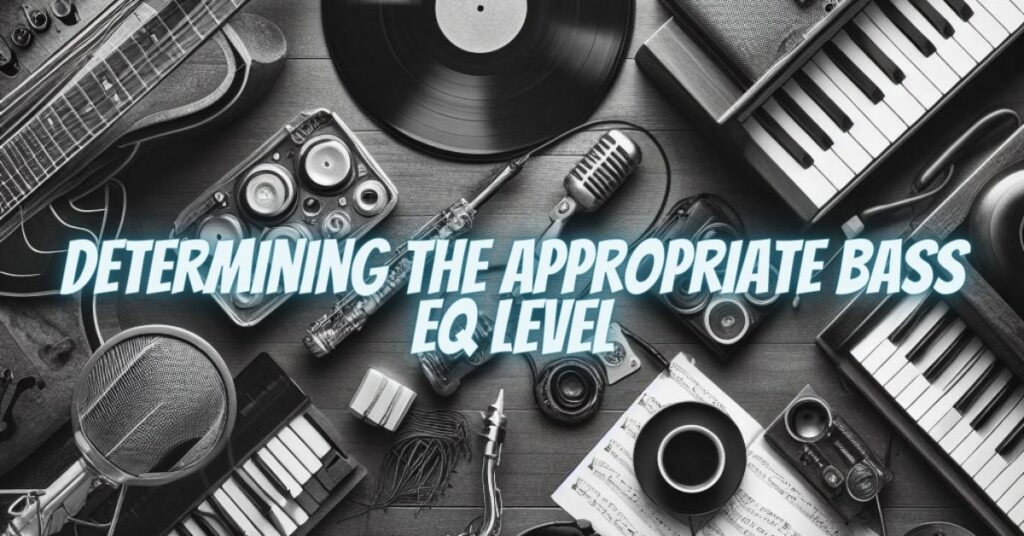The world of audio engineering and music production is a complex realm of art and science. Among the various components that make up sound, bass frequencies are a critical element that can shape the entire sonic experience. Understanding the EQ (equalization) level for bass is a fundamental aspect of audio processing. In this article, we will delve into what EQ level is suitable for bass, exploring the concepts, techniques, and considerations that are essential for achieving a balanced and powerful low-end in audio production.
What Are Bass Frequencies?
To comprehend what EQ level is appropriate for bass, one must first grasp what bass frequencies are. In the context of audio and music production, bass frequencies typically refer to sound waves with lower frequencies, typically ranging from 20 Hz to 250 Hz. These frequencies are characterized by their long wavelengths, which result in a deeper, more resonant quality in the audio spectrum.
Bass frequencies are responsible for providing the foundation and warmth in music. They underpin the rhythm, groove, and overall impact of a track. The balance of bass frequencies is crucial, as too much can lead to muddiness and distortion, while too little can result in a thin and weak sound.
The Role of Equalization (EQ)
Equalization, or EQ, is a fundamental tool in audio processing. It allows sound engineers and producers to shape the frequency content of audio signals by boosting or attenuating specific frequency ranges. EQ can be applied to individual tracks, groups of tracks, or the entire mix to enhance the overall sound.
In the context of bass, EQ is used to refine the balance between low, mid, and high-frequency components. It can help eliminate unwanted resonances, enhance the perceived depth, and ensure that the bass is well-defined and audible on a variety of playback systems.
Setting the EQ Level for Bass
There is no one-size-fits-all answer to the question of what EQ level is ideal for bass. The appropriate EQ level for bass depends on various factors, including the genre of music, the individual track’s role within the mix, and the preferences of the producer or engineer. However, several guidelines and techniques can help achieve a balanced bass sound:
- High-Pass and Low-Pass Filters: Using high-pass filters on non-bass instruments and low-pass filters on the bass can help prevent frequency overlap and ensure clarity in the low end.
- Subtractive EQ: Start by identifying and attenuating any unwanted frequencies in the bass, such as muddiness or boxiness. These problematic areas are often found in the 100-250 Hz range.
- Boosting Fundamental Frequencies: To make the bass sound full and present, boost its fundamental frequencies. This is usually found in the 40-80 Hz range, but it can vary depending on the instrument and the mix.
- Harmonic Enhancement: Emphasizing the harmonics of the bass can add definition and articulation. Boosting frequencies in the 80-200 Hz range can enhance harmonics.
- Dynamic EQ: Dynamic EQ can be used to control wayward peaks or resonances in the bass without affecting the overall tonal balance.
- Reference Listening: Regularly reference your mix on a variety of playback systems to ensure that the bass is well-balanced and translates effectively.
Genre and Personal Preferences
The genre of music plays a significant role in determining the EQ level for bass. For example, electronic dance music (EDM) often features prominent and powerful bass frequencies, while jazz or classical music might require a subtler, more natural low end. Understanding the conventions of your chosen genre is essential when making EQ decisions.
Additionally, personal preferences and artistic intentions are essential factors in shaping the EQ level for bass. Some producers and engineers prefer a more pronounced and driving bass, while others aim for a more transparent, supportive role. The desired emotional impact of the music also influences EQ choices.
Room Acoustics and Monitoring
Room acoustics and monitoring systems are crucial considerations when determining the EQ level for bass. The acoustics of the room in which you’re mixing can significantly affect how you perceive low frequencies. Standing waves and resonances in the room can lead to inaccurate judgments about the bass’s balance. Investing in acoustic treatment and high-quality studio monitors can help mitigate these issues and lead to more accurate EQ decisions.
In the world of audio production, understanding what EQ level is suitable for bass is a critical skill. Bass frequencies are the foundation of music, and striking the right balance is essential for creating impactful and well-rounded mixes. The EQ level for bass can vary depending on genre, personal preferences, and the artistic vision of the producer or engineer. Using techniques such as high-pass and low-pass filters, subtractive EQ, harmonic enhancement, and dynamic EQ can help shape the bass sound to fit the context of the mix. Ultimately, a combination of technical knowledge and artistic intuition is required to achieve a powerful and balanced bass that resonates with the audience.


